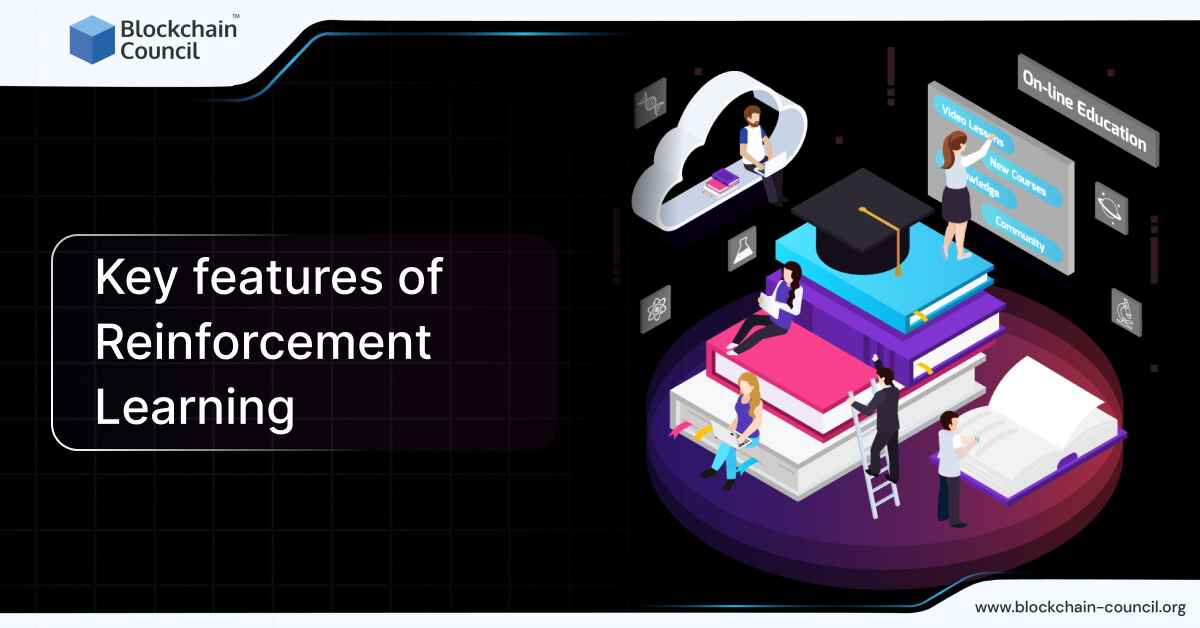
- Blockchain Council
- January 16, 2025
Summary
- Reinforcement learning (RL) is a branch of artificial intelligence focused on decision-making through trial and error, gaining attention for its applications in various domains like robotics, gaming, finance, and healthcare.
- RL involves an agent learning to make decisions by interacting with an environment, adapting its strategy based on feedback in the form of rewards or penalties to maximize total reward.
- Key components of RL include the environment, agent, action, state, reward, policy, and value, which collectively enable learning and decision-making.
- RL features exploration vs. exploitation balance, temporal difference learning, model-based vs. model-free learning, trial-and-error learning, sequential decision-making, adaptability, and goal-oriented learning.
- Exploration involves trying new actions, while exploitation utilizes current knowledge for actions with the highest rewards, balancing these strategies is crucial for efficient learning.
- Temporal Difference (TD) Learning addresses delayed rewards by allowing the agent to learn from future reward estimates.
- RL can be model-based, where the agent builds a model of the environment, or model-free, where it learns directly from experiences.
- Trial-and-error learning enables RL agents to learn from consequences, refining strategies over time.
- Sequential decision-making considers the long-term impact of actions in complex environments.
- RL’s adaptability, goal-oriented approach, and estimation of policies and value functions make it effective in solving diverse real-world problems, driving innovation across industries.
Reinforcement learning is a cutting-edge branch of artificial intelligence (AI) that enables machines to learn and make decisions through trial and error, striving towards achieving specific goals. In recent years, RL has gained significant attention due to its remarkable capabilities in various domains, including robotics, gaming, finance, and healthcare.
In this article, we’ll delve into the fundamental aspects of reinforcement learning, exploring its key features, applications, and potential impact on diverse industries.
What is Reinforcement Learning?
RL or Reinforcement Learning is all about decision-making. It’s a type of machine learning technique where an agent learns to make decisions by interacting with an environment. An RL agent learns to make a series of decisions to achieve a specific goal, adapting its strategy based on feedback from the environment. This feedback comes in the form of rewards or penalties, with the aim of maximizing the total reward. Over time, the agent learns which actions lead to better outcomes, improving its decision-making abilities. This learning method has diverse applications, from game playing and robotics to complex problem-solving tasks like self-driving cars and optimizing treatment plans in healthcare.
Key Components of Reinforcement Learning
Also Read: What is Reinforcement Learning (RL)?
What are the Key Features of Reinforcement Learning?
Below, we delve into some of the key features that make RL both unique and powerful:
Exploration vs. Exploitation
A fundamental aspect of RL is the balance between exploration and exploitation. Exploration involves the agent trying new actions to discover their effects and find more rewarding outcomes. In contrast, exploitation involves using the agent’s current knowledge to take actions known to yield the highest rewards. The challenge lies in balancing these two strategies to ensure the agent does not become too cautious (exploiting too much) or too reckless (exploring excessively), thus optimizing its learning efficiency and effectiveness.
Delayed Rewards and Temporal Difference Learning
One of the distinguishing characteristics of RL is its handling of delayed rewards. Unlike immediate reward scenarios, RL often deals with situations where the consequences of an action are not immediately apparent. Temporal Difference (TD) Learning is a method within RL that addresses this by enabling the agent to learn from an estimate of future rewards rather than waiting for the final outcome. This approach allows for more flexible and efficient learning, especially in complex environments where immediate feedback is not available.
Model-Based vs. Model-Free Learning
RL can be categorized into two main approaches based on how the agent learns from its environment: model-based and model-free learning. In model-based RL, the agent builds a model of the environment that it uses to make predictions about future states and rewards, thus facilitating planning and decision-making. This approach is useful in environments where it is feasible to construct accurate models. On the other hand, model-free learning does not involve building a model of the environment. Instead, the agent learns a policy or value function directly from its experiences, making it more suitable for situations where modeling the environment is impractical or impossible. Each approach has its applications, advantages, and challenges, and the choice between them depends on the specific requirements of the task at hand.
Trial-and-Error Learning
At the heart of RL is the trial-and-error learning process. This foundational strategy allows an RL agent to explore an environment by attempting various actions and observing the outcomes. Unlike traditional learning methods that rely on a predefined dataset, RL agents learn from the consequences of their actions, making mistakes and reaping rewards along the way. This process enables the agent to gradually refine its strategy to maximize cumulative rewards over time, embodying the essence of learning from experience.
Sequential Decision Making
Sequential decision-making is another cornerstone of RL. Here, decisions are not made in isolation; each choice impacts future decisions and outcomes. This feature is critical in complex environments where the consequences of actions unfold over time. An RL agent must consider the long-term effects of its actions, strategizing over a sequence of steps to achieve its goal. This aspect of RL is particularly relevant in scenarios like game playing, navigation, or financial investment, where foresight and planning are crucial.
Adaptability and Learning from Interaction
Adaptability and the ability to learn from interaction with the environment are what make RL agents remarkably effective for a wide range of applications. Through continuous interaction with their environment, RL agents adapt their behavior based on the feedback received in the form of rewards or penalties. This dynamic learning process allows RL agents to tackle problems in changing environments and learn new strategies as they gain more experience. Whether it’s adjusting to new game rules, adapting to market changes, or navigating unfamiliar terrains, the adaptability of RL agents demonstrates the power of learning from interaction.
Goal-Oriented Learning
Goal-oriented learning is the driving force behind RL. Unlike other machine learning approaches that might predict the next word in a sentence or classify images, RL is designed to achieve a specific goal. This could range from a robot learning to navigate a maze to a computer program outplaying humans in complex board games. The key is that the RL agent must figure out how to achieve these goals through trial and error, making decisions that balance immediate rewards with long-term strategy. This aspect of RL emphasizes its utility in solving problems where the best course of action is not known in advance and must be discovered through interaction with the environment.
Also Read: Top 10 Machine Learning Projects In 2024
Policy and Value Function Estimation
Central to RL are the concepts of policy and value function estimation, which together guide the learning process of an agent.
- Policy: A policy is a strategy that the agent employs to decide its actions at each state. It’s essentially a mapping from perceived states of the environment to actions to be taken when in those states. Policies can be deterministic, where a state leads to a specific action, or stochastic, involving probabilities of different actions. The ultimate goal in RL is to find the optimal policy that maximizes the cumulative reward over time.
- Value Function: While the policy tells an agent what to do, the value function estimates the worth of being in a certain state, or how good it is for the agent to be in a given state. There are two main types of value functions – a state value function, which estimates how good it is to be in a particular state, and an action value function, which estimates how good it is to perform a particular action in a particular state. The value function helps the agent to evaluate the potential long-term return of states and actions, guiding it toward the most rewarding paths.
Latest Trends in Reinforcement Learning
Integration with Large Language Models (LLMs)
Recent advancements see RL integrating with Large Language Models (LLMs) to enhance learning and exploration capabilities. For instance, ELLM leverages GPT-3 for generating exploratory goals and employs SentenceBert embeddings to calculate the similarity between these goals and demonstrated behaviors, serving as an intrinsically motivated reward mechanism. This novel approach utilizes the vast knowledge embedded in pre-trained LLMs to automatically generate goals that are diverse, sensible, and context-sensitive, thereby making goal-based exploration more effective and aligned with human-like understanding and decision-making processes.
Automated Feature Engineering and Neural Architecture Search
Automated Feature Engineering and Neural Architecture Search are pivotal in reducing human intervention in model development. By automating the selection of the best model architectures, these technologies significantly lower the barriers to entry for deploying sophisticated machine learning models, making it easier for organizations to leverage advanced AI capabilities without the need for extensive expertise in model design and tuning.
Reinforcement Learning from Human Feedback (RLHF)
This approach combines traditional RL techniques with human feedback to improve learning efficiency and effectiveness. By integrating human insights, RL models, such as language models including ChatGPT, are becoming more aligned with human preferences and understanding, enhancing their applicability in real-world scenarios.
Robotic Pre-Training and Offline RL
These methods focus on training robots in simulated or offline environments before applying learned skills in the real world. Such pre-training helps in overcoming the challenges associated with real-time learning in complex and unpredictable environments, significantly improving the efficiency and safety of robotic applications.
Neural Architecture Search (NAS)
This trend involves using RL to automatically discover the best neural network architectures for given tasks. This automation can significantly reduce the time and expertise required to design effective deep learning models, making advanced AI more accessible across industries.
Reinforcement Learning for Cybersecurity
RL’s application in cybersecurity demonstrates its potential to revolutionize how threats are identified and addressed. By learning to recognize patterns and anomalies in data, RL-powered tools can proactively detect and respond to cybersecurity threats, enhancing the protection of digital assets and infrastructure. The adaptability of RL algorithms means they can continually evolve in response to new and emerging threats, offering a dynamic solution to the challenge of maintaining cybersecurity in an ever-changing digital landscape.
Also Read: Top 10 Must-Have Machine Learning Skills
Challenges Ahead
While RL continues to advance, it also faces several challenges:
- Data Efficiency: RL often requires a large amount of data to learn effectively, which can be a barrier in environments where data is scarce or expensive to obtain.
- Complexity and Computation Cost: The complexity of designing RL algorithms that can handle real-world nuances, along with the high computational costs associated with training, remains a significant challenge.
- Ethical and Safety Concerns: As RL applications become more widespread, ensuring that these systems make decisions that are ethical and safe for all stakeholders is of paramount importance.
Also Read: Deep Learning vs Machine Learning vs Artificial Intelligence: A Beginner’s Guide
Conclusion
In conclusion, reinforcement learning offers a promising framework for training intelligent systems to adapt and excel in dynamic environments. By understanding its key features, such as reward mechanisms, exploration-exploitation trade-offs, and temporal difference learning, we can harness the full potential of RL algorithms to tackle real-world challenges effectively.
As the field continues to advance rapidly, staying updated on the latest developments and techniques in reinforcement learning will be essential for professionals and researchers alike. With its wide-ranging applications and transformative capabilities, reinforcement learning is poised to revolutionize numerous industries, driving innovation and reshaping the future of AI-powered technologies.
Frequently Asked Questions
What is reinforcement learning?
- Reinforcement learning (RL) is a type of machine learning where an agent learns to make decisions by interacting with an environment.
- It involves learning from feedback in the form of rewards or penalties, with the goal of maximizing cumulative rewards over time.
- RL enables machines to adapt and improve their decision-making abilities through trial and error.
- Applications of RL range from game playing and robotics to complex problem-solving tasks like autonomous driving and healthcare optimization.
How does reinforcement learning work?
- In RL, an agent interacts with an environment by taking actions based on its current state.
- The environment provides feedback to the agent in the form of rewards or penalties, indicating the quality of its actions.
- The agent learns from this feedback, adjusting its strategy to maximize rewards over time.
- Key components of RL include the environment, agent, action, state, reward, policy, and value function.
What are the key features of reinforcement learning?
- Exploration vs. Exploitation: Balancing between trying new actions and exploiting known strategies.
- Delayed Rewards and Temporal Difference Learning: Handling situations where rewards are not immediate.
- Model-Based vs. Model-Free Learning: Approaches based on whether the agent builds a model of the environment.
- Trial-and-Error Learning: Learning from experience rather than predefined datasets.
What are the challenges of reinforcement learning?
- Data Efficiency: RL often requires large amounts of data to learn effectively.
- Complexity and Computation Cost: Designing algorithms for real-world nuances and high computational costs.
- Ethical and Safety Concerns: Ensuring RL systems make ethical and safe decisions.
- Overcoming these challenges is crucial for the widespread adoption and success of RL across various industries.

































































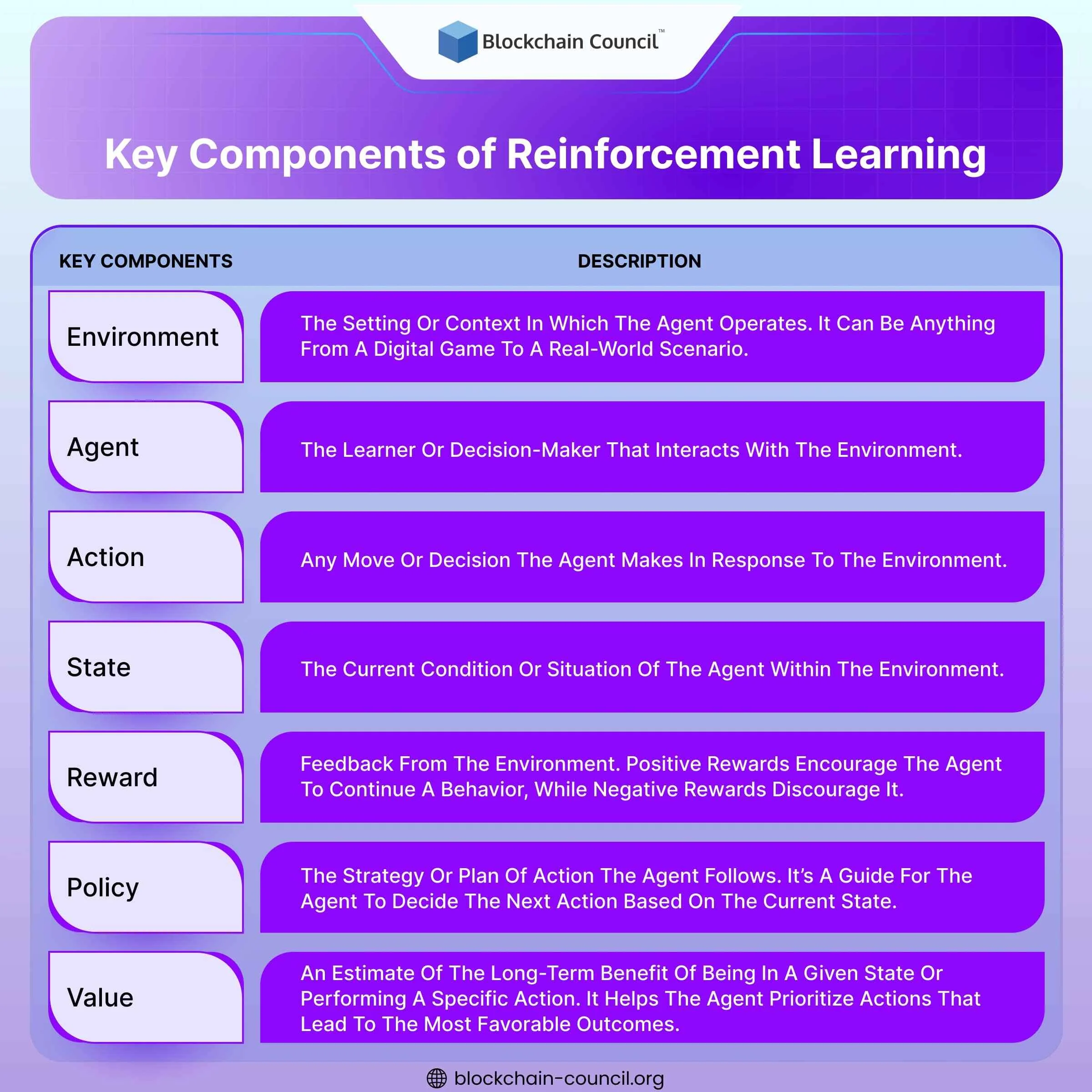
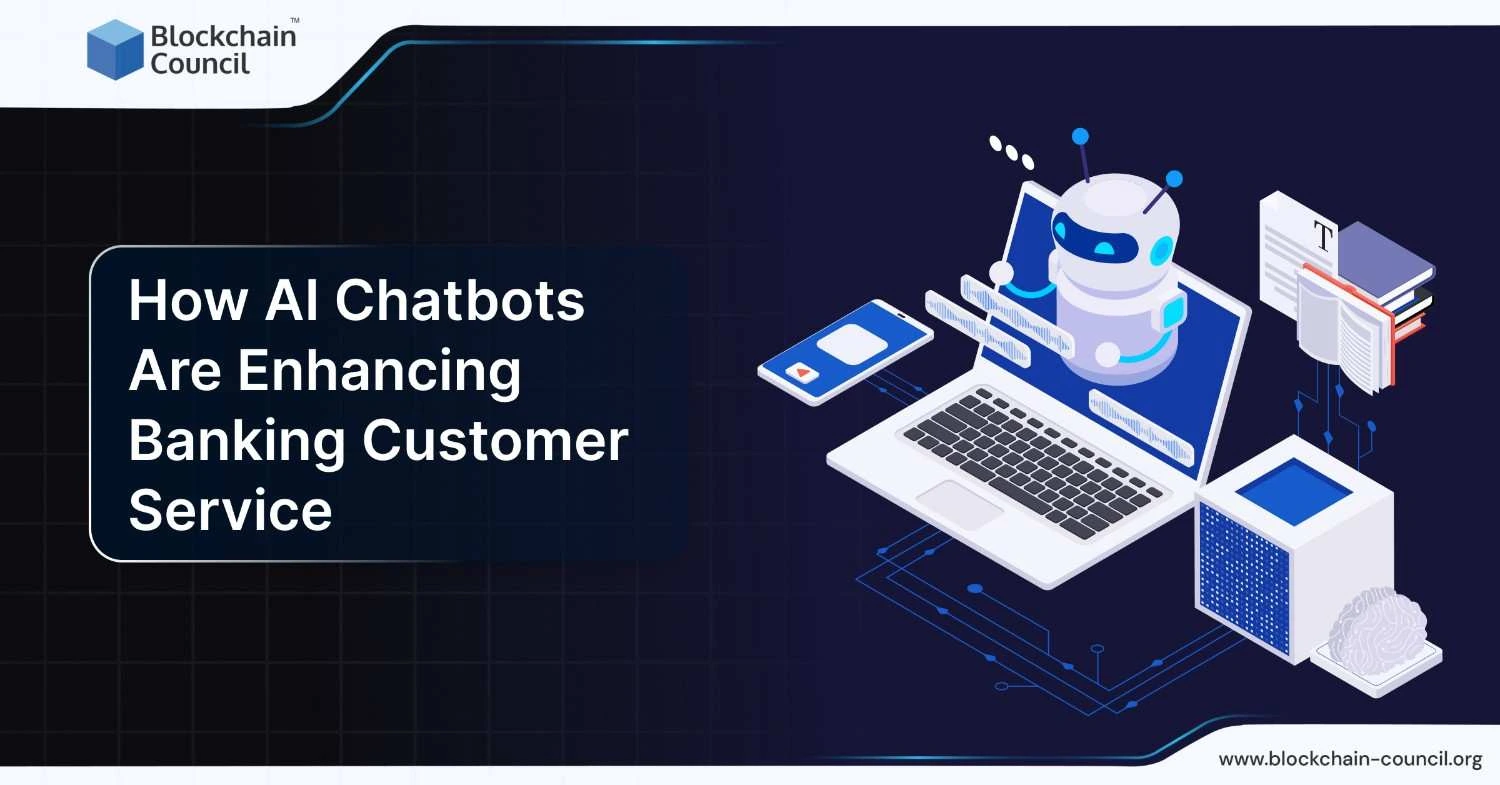
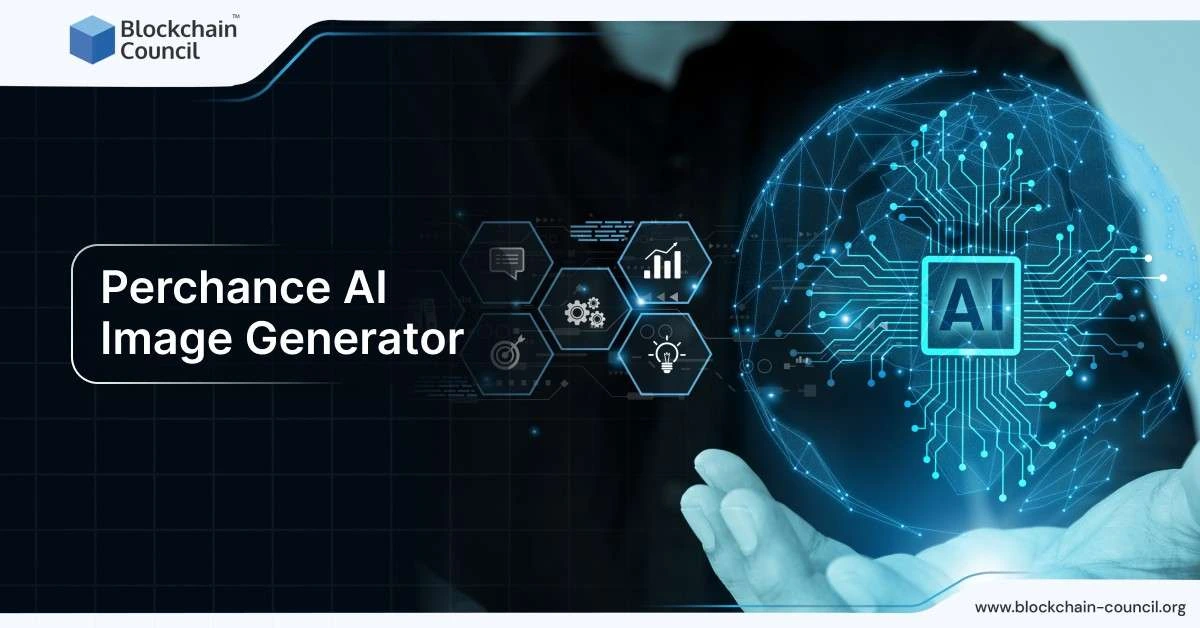

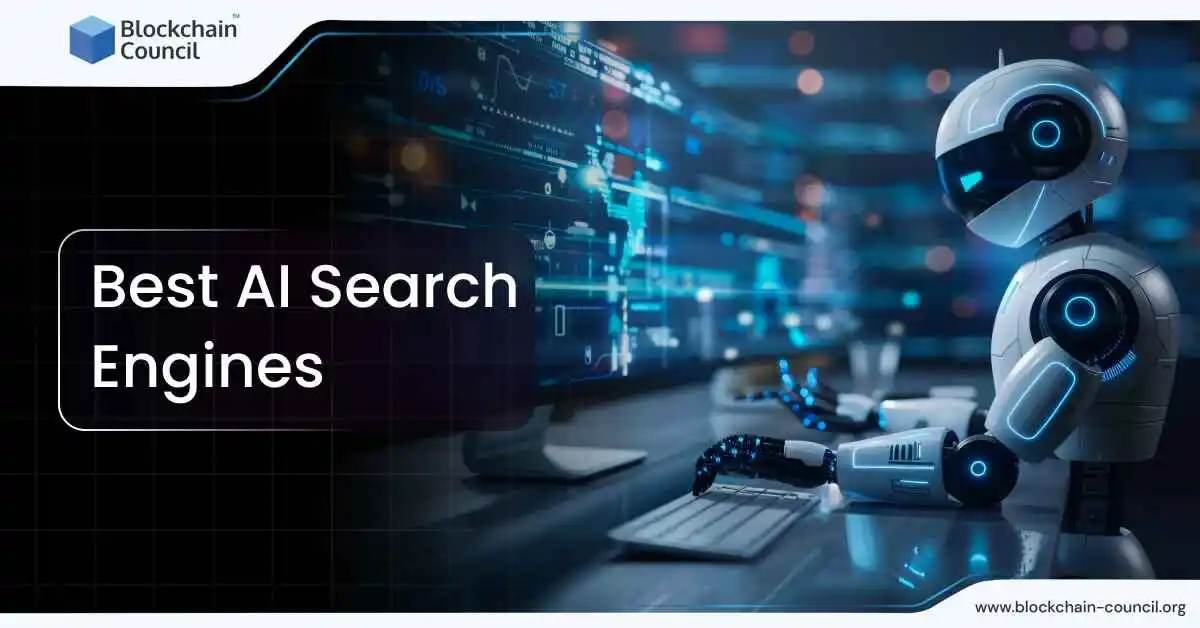
 Guides
Guides News
News Blockchain
Blockchain Cryptocurrency
& Digital Assets
Cryptocurrency
& Digital Assets Web3
Web3 Metaverse & NFTs
Metaverse & NFTs
